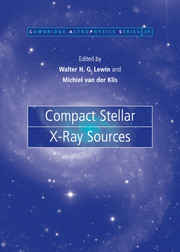Book contents
- Frontmatter
- Contents
- List of contributors
- Preface
- 1 Accreting neutron stars and black holes: a decade of discoveries
- 2 Rapid X-ray variability
- 3 New views of thermonuclear bursts
- 4 Black hole binaries
- 5 Optical, ultraviolet and infrared observations of X-ray binaries
- 6 Fast X-ray transients and X-ray flashes
- 7 Isolated neutron stars
- 8 Globular cluster X-ray sources
- 9 Jets from X-ray binaries
- 10 X-rays from cataclysmic variables
- 11 Super-soft sources
- 12 Compact steller X-ray sources in normal galaxies
- 13 Accretion in compact binaries
- 14 Soft gamma repeaters and anomalous X-ray pulsars: magnetar candidates
- 15 Cosmic gamma-ray bursts, their afterglows, and their host galaxies
- 16 Formation and evolution of compact stellar X-ray sources
- Author index
- Subject index
11 - Super-soft sources
Published online by Cambridge University Press: 01 September 2009
- Frontmatter
- Contents
- List of contributors
- Preface
- 1 Accreting neutron stars and black holes: a decade of discoveries
- 2 Rapid X-ray variability
- 3 New views of thermonuclear bursts
- 4 Black hole binaries
- 5 Optical, ultraviolet and infrared observations of X-ray binaries
- 6 Fast X-ray transients and X-ray flashes
- 7 Isolated neutron stars
- 8 Globular cluster X-ray sources
- 9 Jets from X-ray binaries
- 10 X-rays from cataclysmic variables
- 11 Super-soft sources
- 12 Compact steller X-ray sources in normal galaxies
- 13 Accretion in compact binaries
- 14 Soft gamma repeaters and anomalous X-ray pulsars: magnetar candidates
- 15 Cosmic gamma-ray bursts, their afterglows, and their host galaxies
- 16 Formation and evolution of compact stellar X-ray sources
- Author index
- Subject index
Summary
Introduction
The luminous super-soft X-ray sources (SSS) were recognized as an important new class of intrinsically bright X-ray sources by Trümper et al. (1991) (see also Greiner et al. 1991). In fact four of them had already been found in the Magellanic Clouds with the Einstein Observatory around 1980, but they had not been recognized as a separate new class (Long et al. 1981; Seward & Mitchell 1981). A careful analysis of the ROSAT data on the first LMC sources showed that while their X-ray luminosities can be as high as the Eddington limit (they range from ∼1036 to 1038 erg s−1), their X-ray spectra are extremely soft, typically peaking in the range 20–100 eV, corresponding to blackbody temperatures of ∼105 to ∼106 K. This is some two orders of magnitude lower than for a classical X-ray binary that contains an accreting neutron star or black hole. Some 40 SSS have been discovered with ROSAT, 16 in the Andromeda Nebula (M31), about a dozen in the Magellanic Clouds, 10 in our own Galaxy and one in NGC55. Since then, several dozens of SSS have been discovered with BeppoSAX, Chandra and XMM-Newton, mostly in external galaxies. The latter are listed in Section 11.10. A catalog of SSS is given in Greiner (2000a).
- Type
- Chapter
- Information
- Compact Stellar X-ray Sources , pp. 461 - 474Publisher: Cambridge University PressPrint publication year: 2006
- 15
- Cited by

